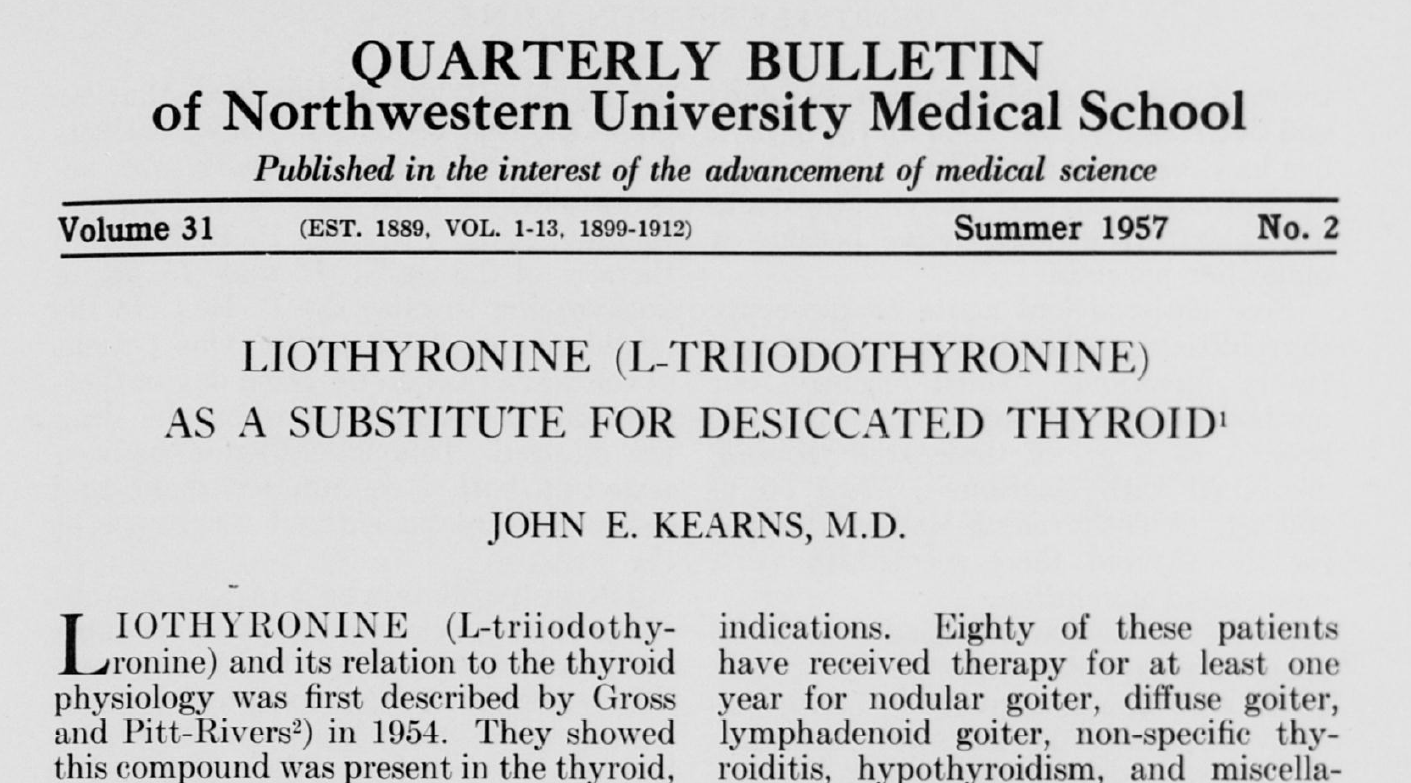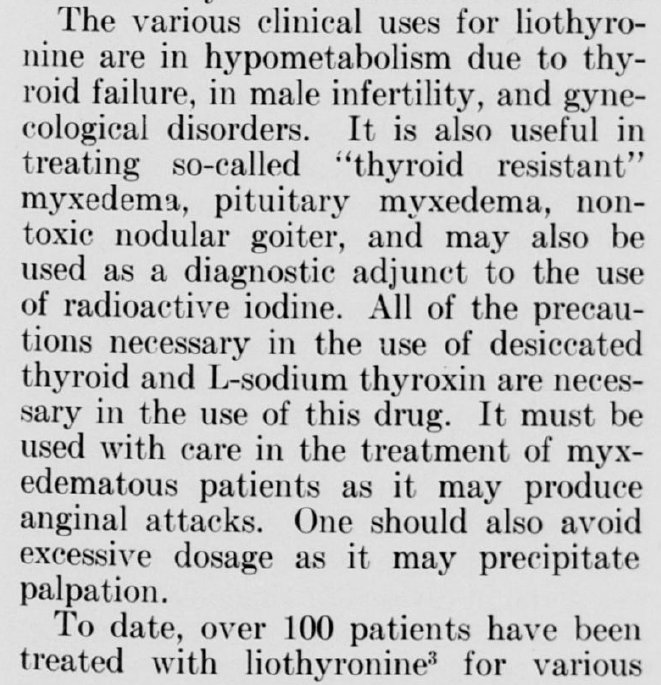Sometimes science does not retain knowledge, but rather chooses to forget.
After endocrinology fell in love with L-T4 monotherapy, it was too tempting to forget the history of the OTHER monotherapy — L-T3 monotherapy.
Modern doctors might assume that because they didn’t have the TSH test back then, they were blind! They had no way of knowing whether they were harming patients! But no, that’s not true. Before the TSH test, we collected a wide range of data on thyroid levels, more data than we now collect since we fixate on TSH alone.
Let’s review some of what we learned.
In John E. Kearns’ 1957 article “Liothyronine (l -triiodothyronine) as a substitute for desiccated thyroid” reported that “over 100 patients” had been treated with liothyronine. “Eighty of these patients have received therapy for at least one year” for a wide variety of health conditions.
 What doses did they find were effective?
What doses did they find were effective?
What side effects did they find?
What was the average equivalency between Liothyronine (L-T3) and desiccated thyroid (DTE)?
Kearns reported that
- 22 people whose thyroid had been removed or ablated “responded satisfactorily to liothyronine.
- Their dosage varied from 25mcg to 75 mcg. per day.”
In 36 other hypothyroid subjects, presumably with different levels of thyroid function and different levels of absorption,
- “doses of liothyronine of between 12.5 and 400 mcg. per day”
- The patient taking 400mcg was “a 42-year old physician who had been on 3 gr. of desiccated thyroid daily,” but another patient felt that 50mcg of L-T3 was equivalent to 3 gr. of desiccated thyroid.
- “most of the patients with primary hypothyroidism felt better on liothyronine than desiccated thyroid.” Three patients preferred desiccated thyroid to L-T3 or found little difference.
Other types of patients were treated with L-T3:
- Thirteen patients were treated for nodular lesions of the thyroid (clinical single
nodule). The average dose of liothyronine was between 25 and 50 mcg. with the highest 100 mcg, and the lowest 12.5 mcg. per day. Following the surgical removal of the lesion those people with hypothyroidism were continued on liothyronine and have shown no adverse effects. - Seven patients have been treated for diffuse goiter. In three young children, average age of 8 years, with a diffuse goiter, the lesions have diminished in
size on 25 mcg. of liothyronine twice daily with drops of iodine. - Four patients were found to have lymphadenoid type of goiter. These patients were placed on 50 mcg of liothyronine twice daily.
- Several patients were treated with L-T3 for non-thyroidal conditions: “hypometabolism” (low basal metabolic rate), “mild depression,” “hypomennorhea” (lack of menstruation), and the article claimed it was also useful to treat “male infertility”
 As for safety, Kearns was of the opinion that liothyronine was equally dangerous as other thyroid medications such as L-T4 and desiccated thyroid. However, due to its potency, Liothyronine ought to be handled with due care:
As for safety, Kearns was of the opinion that liothyronine was equally dangerous as other thyroid medications such as L-T4 and desiccated thyroid. However, due to its potency, Liothyronine ought to be handled with due care:
- “All of the precautions necessary in the use of desiccated thyroid and L-socium thyroxin [L-T4] are necessary in the use of this drug.”
- “It must be used with care in the treatment of myxedmatous patients [who are extremely hypothyroid] as it may produce anginal attacks” because it directly raises metabolic rate.
- “one should also avoid excessive dosage as it may precipitate palpation” — so keep doses small while increasing slowly.
Back in the 1950s when treating patients, they measured effectiveness by means of many biomarkers (basal metabolic rate, etc.) other than TSH. The Protein Bound Iodine (PBI) test was the closest they came to measuring thyroid hormones. The reduction of goiter (swollen thyroid) and thyroid nodules was a sign of effectiveness as well. Patient symptoms were important data when working toward the euthyroid state.
Kearns’ conclusions:
- “It can be seen from these responses that liothyronine is a very potent thyroidal agent. Its effect is more rapid than that of desiccated thyroid, but comparable to thyroxine (T4).”
- “There are a few people who cannot tolerate this drug either because of allergic or nervous reactions.”
- “Approximately 62.5 mcg. of liothyronine seemed to be equal to about two grains (0.12 gm.) of deisiccated thyroid.”
- “In conclusion, we have found that patients with various thyroidal conditions respond quite well to therapy with liothyronine.”
Want more? Read the section of our Campaign Statement on Rationale: L-T3 monotherapies.

[…] See our review of a 1957 article that described 100 patients’ therapy on L-T3 alone: L-T3 monotherapy in 1957 […]
[…] When I first started the journey, I wasn’t sure what dose I would end up on. Some of my friends are on 60/day, others on 100/day or 120. I’ve read of higher maintenance doses in the medical literature from the 1950s. […]
[…] HISTORY: L-T3 monotherapy in 1957 […]
[…] Read another review, “HISTORY: L-T3 monotherapy in 1957” […]
I needed 300 mcg after I had gained weight, hypothyroidism is horrible. When I first began taking T3, I needed 75 mcg 3 x a day and was able to keep my size 2 figure at this dose. Later on, I needed more because I had gained weight due depression caused by a life changing move. It’s been a few years since the move and I haven’t been the same. I recently began my journey on carnivore and for some reason, I began feeling extremely depressed … my dose at this time was 75 mcg 2 x a day.. feeling super fatigued. It could be that my transition from carbs to fat is much more difficult this time around. I
Cannot function like this, I’m hoping to be well soon.